[Ed. note: In celebration of Artblog’s 10-year anniversary, we are bringing you content from our inaugural year, 2003. In July, 2003, we explored the idea of space. From moving space at the Barnes, to using it at the ICA, we questioned the “where” and “when” of how it should be used effectively. It is fascinating to read through these posts and see how far both of these institutions have come in settling into and establishing their own distinctive spaces.]
——————————-
Barnes musings
By roberta
I read last week that Pennsylvania Attorney General Mike Fisher finally weighed in on the Barnes Foundation controversy. Fisher, who represents the interests of the public in the matter, sided strongly with the Barnes, saying the institution should be allowed to move the collection and to change the size and composition of its board. (For more, see Patricia Horn’s story in the Philadelphia Inquirer, July 24, 2003)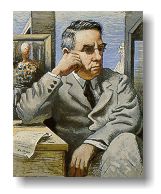
I toured the Barnes last year with Kimberly Camp, the current director. Camp, admittedly, is not an impartial observer. But she paints a convincing case that Albert Barnes’s mission is being thwarted under current conditions that severely restrict the number of visitors — and thus revenue — to run the place.
Barnes [image above is portrait of Barnes by Giorgio deChirico] was an art education missionary who believed in using his institution to educate and to foster dialog about art. He and John Dewey [see photo, below] thought art education would create a better democracy.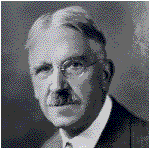
You have to assume that Camp and the others advocating the move had Barnes’ original mission in mind when they made their petition to the Orphans Court. I can’t believe that they want to turn the whole thing into a museum, an art cash cow on the Parkway.
Wouldn’t it be better if the collection moves, lock, stock and education program, to a location where the neighbors want it and where a broader group of people has a chance to come in and participate?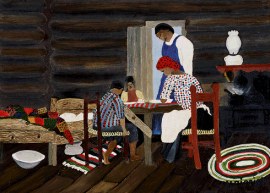
We could sure use a better democracy these days. I’m rooting for the Barnes to win this one. The judge will rule on the matter in December. Meanwhile, if you’ve never been to the Barnes, and chances are you haven’t, try to go — set eyes on the place. But be forewarned, you need to call, fax or email the Barnes to reserve a ticket in advance for their limited open hours on Wednesdays, Thursdays and Fridays between 9:30 am-5:00 pm. (But August is the month to go. There’s only a one-week booking delay. Other months you may wait 30 days or longer to get a reservation.) [image above, from the Barnes collection, is Horace Pippin’s “Giving Thanks” 1942]
——————————-
Precious space
By roberta
Astrid [Bowlby] raises an interesting point about the ICA’s cavernous space and its effect on Polly Apfelbaum’s work. [See her post of July 9.] The museum’s ambiance downstairs is more like an airplane hangar than a gallery. (DIA’s space in Chelsea seems this way, too. Image below of Dia’s Rosemarie Trockel exhibit — closed for the summer, re-opening in October.) What seems to work best in these spaces is art that becomes an airplane, that is, art that’s “big” enough to create a wow in and of itself. (Last year’s Space 1026 installation did this, as did the Wall Power show and Bruce Yanemoto’s video fireworks, to name a few.)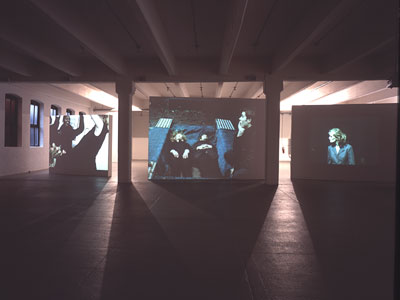
What also works is art that creates intimacy with the viewer–art that makes the space irrelevant. Charles LeDray drew you in with his small, intricate pieces focussed on the human body. Even Lisa Yuskavage did this. Her work focussed on such private aspects of the body that it forced aside all thoughts about the ICA’s external space. Who cared?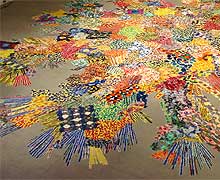
Apfelbaum’s floor-bound work (See image of “Reckless”) is neither an airplane nor is it particularly intimate. With the exception of “Bones” and “Compulsory Figures,” both of which evoke the body directly as a vulnerable, mortal object, the rest of the work is like the Milky Way, beautiful and fascinating but outside the human experience.
That said, I loved it all. But I think Astrid is right that Apfelbaum’s pieces, which look quite different in more intimate spaces, didn’t get their best showing in the big space.
Come to think of it, the piece that works best in the ICA might be the wallpaper which creates a hazy veil of color and makes the walls fade away. It’s a stealth bomber if you will. Apfelbaum’s work is at the ICA until July 27.









